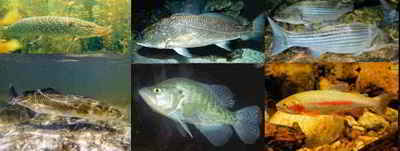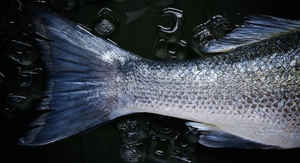Alabama Symbols
Alabama State Freshwater Fish
Largemouth Bass

(Micropterus salmoides)
Adopted on October 10, 1975.
By Act no. 1183 on October 10, 1975, the largemouth bass, (Micropterus salmoides,) was chosen as the state freshwater fish. The Legislature erred, however in the wording of the legislation. In Act No. 1183, 1975 when they designated the Largemouth Bass as the official state freshwater fish, they incorrectly identified it by the Latin name Micropterus punctulatus, which is actually the Spotted Bass.
Did you know that: Largemouth Bass has been proclaimed the official State Freshwater Fish in each of the following states
Mississippi, and Tennessee (Old).
Alabama State Freshwater Fish: Largemouth Bass

Largemouth Bass is abundant in Alabama inland waters and popular with sport fishermen. It can be found throughout the United States in ponds, lakes, and rivers.
Micropterus is Greek, meaning "small fin." Salmoides is from the Greek salmo, meaning "trout", and refers to the fact that largemouth bass have been called "trout" in some southern states.
Other Common Names of the Largemouth Bass
Black Bass, Green Bass, Bigmouth, Linesides, Bucketmouth
Characteristics of the Largemouth Bass
They are sexually mature at just over 2 years of age (52cm in length). Largemouth bass have a black to green back with lighter sides and a pale belly. They have a dark wavy band running the length of their sides. Their mouth extends beyond their eyes. Most have a black non-defined line running laterally along their body, but in some individuals the line becomes more like a series of blotches. The fins and tail are generally pale brown. Male Largemouth bass are usually more slender and darker in color than females.
Body
Body green-shaded with a broad, continuous dark stripe along each side; belly white to yellowish; dorsal fin almost completely separated between spiny and soft portion and lower jaw extends past the gold-colored eye; commonly reach lengths up to 16 inches by three years of age.
Reproduction
Largemouth bass are greedy predators and become territorial during their spawning season. They practice brood care and build a shallow pit about 1m in diameter, which they clean and line with leaves. They spawn into the pit and the eggs are then guarded alternately by the male and female. The young take about one week to hatch, and after hatching brood care terminates. They preferred Water Temperature: 63-68 °F
Distribution
Largemouth bass are native to North America. They can be found at St. Lawrence, Great Lakes, Hudson Bay (Red River), and Mississippi River Basins, the Atlantic drainages from North Carolina to Florida and to northern Mexico. The species has been widely introduced as a game fish and is now cosmopolitan.
Habitat
Largemouth bass are freshwater fish and generally inhabit clear, vegetated lakes, ponds and swamps. They prefer quiet, clear water and often hide in dense vegetation along the edges of a water body. They preferred temperature is 68-78 °F.
Diet
Largemouth bass have a voracious appetite. Adults feed on fishes, crayfish and frogs, while juveniles feed on crustaceans, insects and small fishes. These fish can become cannibalistic. They do not eat during spawning or when the water temperature is below 5 degrees or above 37 degrees.
Age and Growth
Largemouth bass grow up to 97cm and 10kg and can live as long as 11 years.
Length: Up to 21 inches
Weight: Up to 10 pounds
Life span: Up to 15 years
Alabama Law
The law designating the largemouth bass as the official Alabama state fresh water fish is Section 1-2-9 (State fresh water fish ) of Chapter 2 (State Symbols and Honors) of Title 1 of the Code of Alabama, 1975.
TITLE 1.
Chapter 2 - STATE SYMBOLS AND HONORS.
Section 1-2-9
State fresh water fish.
The largemouth bass, Micropterus punctulatus, is hereby designated and named the official fresh water fish of Alabama.
(Acts 1975, No. 1183, §1.)
The largemouth bass is incorrectly designated as Micropterus punctulatus in the legislation. Micropterus punctulatus identifies
the spotted bass, not the largemouth bass.
Taxonomic Hierarchy: Largemouth Bass
Kingdom: Animalia - animals
Phylum: Chordata - chordates
Subphylum: Vertebrata - vertebrates
Class: Actinopterygii - ray-finned and spiny rayed fishes
Subclass: Neopterygii
Order: Perciformes, perch-like fishes
Suborder: Percoidei
Family:Centrarchidae
Genus: Micropterus
Species: Micropterus salmoides








